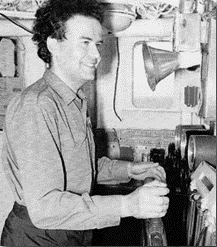REPORT ON THE ROYAL NAVY, 2004
By Julian Lewis MP
 Twenty-five years ago, as Ordinary Seaman Lewis, I served on HMS Glasserton – a broad-beamed wooden minesweeper built in the 1950s. She was the warship allocated to the London Division of the Royal Naval Reserve, but her base port was Southampton.
Twenty-five years ago, as Ordinary Seaman Lewis, I served on HMS Glasserton – a broad-beamed wooden minesweeper built in the 1950s. She was the warship allocated to the London Division of the Royal Naval Reserve, but her base port was Southampton.
Little did I imagine, when travelling down from Waterloo for my “weekends”, that one day I would be making the same trip time and again as a South Coast MP – let alone going to sea with the newest and finest ships in the Navy. I owe these experiences to the electors of New Forest East, on the one hand, and to Sir Neil Thorne and the Armed Forces Parliamentary Scheme, on the other.
Having already benefited from the AFPS on two occasions with the Royal Air Force, I was none too optimistic that a third “bite of the cherry” would be possible, when I served as Shadow Defence Minister for the Royal Navy from 2002 to 2004. However, a place was somehow found on the 2004 course, and I soon embarked upon an integrated series of visits and briefings which were second-to-none.
Every aspect of the Senior Service was made accessible. It quickly became clear that currently much of the Navy is run by a veritable convoy of Commodores. Indeed, a very large quantity of gold braid was generally in evidence – but, interestingly, at least one Commodore stepped down to the substantive rank of Captain when transferring from running a major shore establishment to commanding a major warship.
There seems to be something of an inverse ratio between the numbers of senior officers and the numbers of vessels available to the Fleet: I had noticed something similar in respect of aircraft in the RAF previously. Maybe it is just intelligent anticipation of future expansion in the totals of Service personnel, but there is little evidence of that at present.
Still, whatever our doubts about quantity, there can be none whatever about quality. From Devonport to Dartmouth, from Portsmouth to Yeovilton, and, afloat above all, from the mightiest carriers to the nimblest patrol craft, the Navy’s commitment to the highest professional standards is absolute.
Briefings in the shore establishments were mercifully free of acronyms, jargon and “wiring diagrams”, despite the output of recent Maritime Doctrine which uses a great many words to point out that the Fleet needs to be “versatile”. Many were the opportunities to see how our warships are constructed, serviced, refitted and maintained.
Yet, as is always the case with the AFPS, the most vivid memories were gained on actual deployments. In 2004, as well as demonstrations and exercises in the Channel, the highlights were an extended voyage in the North Sea on the carrier HMS Invincible and a gruelling week (of course) in the Caribbean on the Type-23 frigate HMS Monmouth.
There we saw at first hand the ingenuity of the drug-runners who fit out small boats with up to four extremely powerful outboard motors. No sizeable warship could possibly keep pace with these “go-fast” vessels; but a Lynx helicopter easily can – as one bunch of smugglers found out to their cost in the middle of our voyage. Aboard the Monmouth I met an impressive US Coastguard officer who later spent hours on the captured boat until it and its crew (minus the drugs which had been pitched overboard early in the chase) could be handed over to the Venezuelan authorities.
It cannot be easy for senior officers in the Armed Forces to strike the right balance themselves between personal candour and professional discretion when dealing with provocative questioning by Parliamentarians – still less to contemplate letting MPs loose on the lower decks with unfettered access to the views of Servicemen and women.
It speaks volumes for Sir Neil Thorne that he persuaded them to contemplate this, over a decade ago, and it speaks volumes for the self-confidence of the Services that they agreed then and that they continue to do so.
As always, when coming into contact with our Armed Forces, I draw inspiration and encouragement from the calibre of the people who defend our democratic way of life.